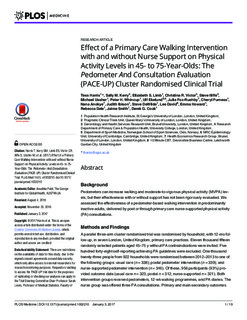| dc.description.abstract | Pedometers can increase walking and moderate-to-vigorous physical activity (MVPA) levels, but their effectiveness with or without support has not been rigorously evaluated. We assessed the effectiveness of a pedometer-based walking intervention in predominantly inactive adults, delivered by post or through primary care nurse-supported physical activity (PA) consultations. Methods and Findings: A parallel three-arm cluster randomised trial was randomised by household, with 12-mo follow-up, in seven London, United Kingdom, primary care practices. Eleven thousand fifteen randomly selected patients aged 45–75 y without PA contraindications were invited. Five hundred forty-eight self-reporting achieving PA guidelines were excluded. One thousand twenty-three people from 922 households were randomised between 2012–2013 to one of the following groups: usual care (n = 338); postal pedometer intervention (n = 339); and nurse-supported pedometer intervention (n = 346). Of these, 956 participants (93%) provided outcome data (usual care n = 323, postal n = 312, nurse-supported n = 321). Both intervention groups received pedometers, 12-wk walking programmes, and PA diaries. The nurse group was offered three PA consultations. Primary and main secondary outcomes were changes from baseline to 12 mo in average daily step-counts and time in MVPA (in ≥10-min bouts), respectively, measured objectively by accelerometry. Only statisticians were masked to group. Analysis was by intention-to-treat. Average baseline daily step-count was 7,479 (standard deviation [s.d.] 2,671), and average time in MVPA bouts was 94 (s.d. 102) min/wk. At 12 mo, mean steps/d, with s.d. in parentheses, were as follows: control 7,246 (2,671); postal 8,010 (2,922); and nurse support 8,131 (3,228). PA increased in both intervention groups compared with the control group; additional steps/d were 642 for postal (95% CI 329–955) and 677 for nurse support (95% CI 365–989); additional MVPA in bouts (min/wk) were 33 for postal (95% CI 17–49) and 35 for nurse support (95% CI 19–51). There were no significant differences between the two interventions at 12 mo. The 10% (1,023/10,467) recruitment rate was a study limitation. Conclusions: A primary care pedometer-based walking intervention in predominantly inactive 45- to 75-y-olds increased step-counts by about one-tenth and time in MVPA in bouts by about one-third. Nurse and postal delivery achieved similar 12-mo PA outcomes. A primary care pedometer intervention delivered by post or with minimal support could help address the public health physical inactivity challenge. | nb_NO |
